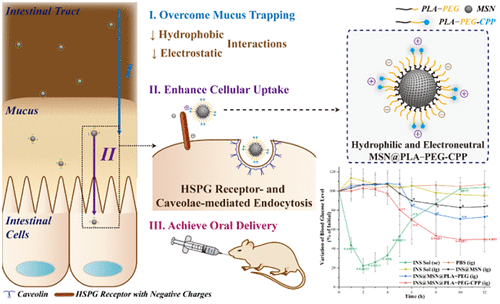当前位置:
X-MOL 学术
›
Mol. Pharmaceutics
›
论文详情
Our official English website, www.x-mol.net, welcomes your
feedback! (Note: you will need to create a separate account there.)
Hydrophilic and Electroneutral Nanoparticles to Overcome Mucus Trapping and Enhance Oral Delivery of Insulin.
Molecular Pharmaceutics ( IF 4.5 ) Pub Date : 2020-07-22 , DOI: 10.1021/acs.molpharmaceut.0c00223 Xinyi Tan 1 , Na Yin 1 , Zixu Liu 1 , Rong Sun 1 , Jingxin Gou 1 , Tian Yin 2 , Yu Zhang 1 , Haibing He 1 , Xing Tang 1
Molecular Pharmaceutics ( IF 4.5 ) Pub Date : 2020-07-22 , DOI: 10.1021/acs.molpharmaceut.0c00223 Xinyi Tan 1 , Na Yin 1 , Zixu Liu 1 , Rong Sun 1 , Jingxin Gou 1 , Tian Yin 2 , Yu Zhang 1 , Haibing He 1 , Xing Tang 1
Affiliation

|
The oral delivery of macromolecules using nanoparticles is limited by secreted mucus, resulting in low contact or internalization via intestinal cells and, thus, both mucus trapping and further low cellular uptake need to be overcome. Here, hydrophilic and electroneutral nanoparticles were developed to overcome mucus trapping and enhance the oral delivery of macromolecules. Mesoporous silica nanoparticles (MSNs) were synthesized and modified with a hydrophilic block polymer (poly(lactic acid)–methoxy poly(ethylene glycol), PLA–PEG), and then an overall electroneutrality and promoted cellular uptake were achieved by sequential modification with cell-penetrating peptides (CPPs). Reduced hydrophobic and electrostatic interactions of MSN@PLA–PEG-CPP with mucus decreased mucus trapping by 36.0%, increased the cellular uptake of MSN@PLA–PEG-CPP by 2.3-folds in mucous conditions via active heparan sulfate proteoglycan receptor (HSPG)-mediated and caveolae-mediated endocytosis and electrostatic interactions. Furthermore, insulin, a model macromolecular drug, was successfully loaded into the nanoparticles (INS@MSN@PLA–PEG-CPP). Compared with insulin solution, in vitro cellular uptake in mucous conditions and in vivo pharmacodynamic effects were significantly increased by 9.1- and 14.2-folds, respectively. As well, all nanoparticles with or without insulin loading presented negligible in vitro and in vivo toxicity. Herein, hydrophilic and electroneutral nanoparticles with sequential PEG and CPP modification could promote cellular uptake against mucus trapping and finally show good prospects for oral insulin delivery.
中文翻译:

亲水性和电中性纳米颗粒可克服粘液捕获并增强胰岛素的口服递送。
利用纳米粒子大分子的口服递送是通过分泌粘液的限制,导致低的接触或内化通过肠道细胞以及粘液捕获以及进一步的低细胞摄取都需要克服。在这里,开发了亲水性和电子中性的纳米粒子,以克服粘液捕获并增强大分子的口服传递。合成并用亲水性嵌段聚合物(聚乳酸-甲氧基聚乙二醇,PLA-PEG)改性介孔二氧化硅纳米粒子(MSNs),然后通过依次修饰细胞获得整体电子中性并促进细胞摄取-穿透肽(CPP)。通过粘液减少MSN @ PLA–PEG-CPP的疏水和静电相互作用,使粘液捕获减少36.0%,在粘液条件下通过MSN @ PLA–PEG-CPP的细胞摄取增加2.3倍,活性硫酸乙酰肝素蛋白聚糖受体(HSPG)介导和小窝介导的内吞作用和静电相互作用。此外,胰岛素(一种模型大分子药物)已成功加载到纳米颗粒中(INS @ MSN @ PLA–PEG-CPP)。与胰岛素溶液相比,在粘液条件下的体外细胞吸收和体内药效学作用分别显着增加了9.1倍和14.2倍。同样,所有具有或不具有胰岛素负载的纳米颗粒在体外和体内的表现都可以忽略不计毒性。本文中,具有连续的PEG和CPP修饰的亲水性和电中性纳米颗粒可以促进细胞对粘液捕获的吸收,并最终显示出口服胰岛素递送的良好前景。
更新日期:2020-07-22
中文翻译:

亲水性和电中性纳米颗粒可克服粘液捕获并增强胰岛素的口服递送。
利用纳米粒子大分子的口服递送是通过分泌粘液的限制,导致低的接触或内化通过肠道细胞以及粘液捕获以及进一步的低细胞摄取都需要克服。在这里,开发了亲水性和电子中性的纳米粒子,以克服粘液捕获并增强大分子的口服传递。合成并用亲水性嵌段聚合物(聚乳酸-甲氧基聚乙二醇,PLA-PEG)改性介孔二氧化硅纳米粒子(MSNs),然后通过依次修饰细胞获得整体电子中性并促进细胞摄取-穿透肽(CPP)。通过粘液减少MSN @ PLA–PEG-CPP的疏水和静电相互作用,使粘液捕获减少36.0%,在粘液条件下通过MSN @ PLA–PEG-CPP的细胞摄取增加2.3倍,活性硫酸乙酰肝素蛋白聚糖受体(HSPG)介导和小窝介导的内吞作用和静电相互作用。此外,胰岛素(一种模型大分子药物)已成功加载到纳米颗粒中(INS @ MSN @ PLA–PEG-CPP)。与胰岛素溶液相比,在粘液条件下的体外细胞吸收和体内药效学作用分别显着增加了9.1倍和14.2倍。同样,所有具有或不具有胰岛素负载的纳米颗粒在体外和体内的表现都可以忽略不计毒性。本文中,具有连续的PEG和CPP修饰的亲水性和电中性纳米颗粒可以促进细胞对粘液捕获的吸收,并最终显示出口服胰岛素递送的良好前景。











































 京公网安备 11010802027423号
京公网安备 11010802027423号